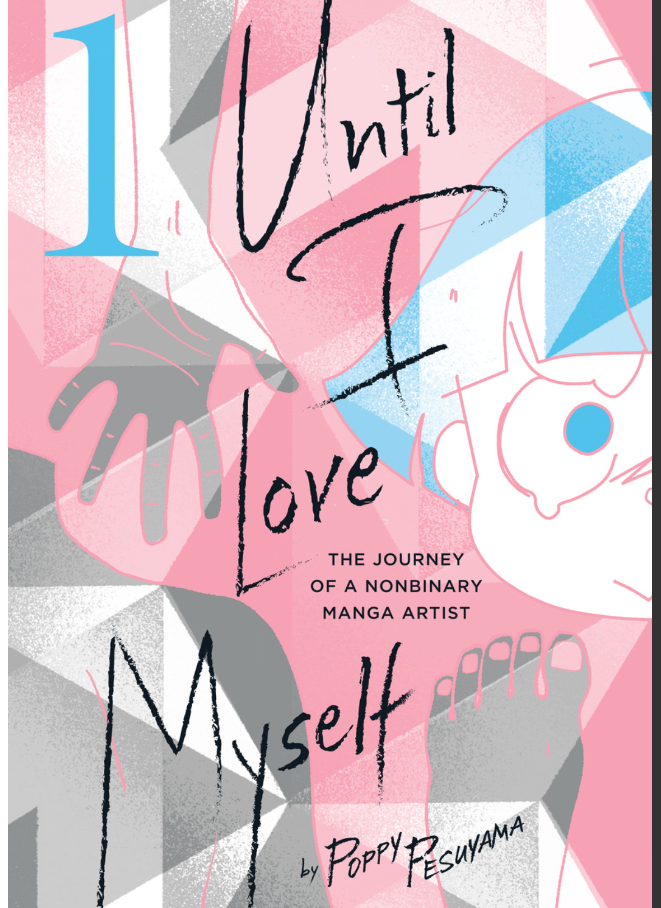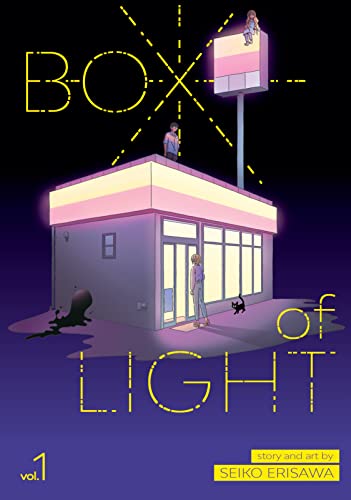Compare and Contrast: Two Nonbinary Autobiographical Manga

My wife is now on the board of the Friends of the Library. She doesn’t drive, so I was stuck hanging out, waiting for her meeting to end for several hours last night. During that time, I managed to read two sets of autobiographical manga about nonbinary manga artists: X-Gender/Seibetsu X by Miyazaki Asuka and Until I Love Myself: The Journey of a Nonbinary Manga Artist by Pesuyama Poppy.
SPOILERS
.
.
.
.
CONTENT WARNING: Sexual Harassment and Discussions of Suicide
Where to even begin….
I think the best place to start is to remind longtime readers of one of the other autobiographical series I’ve read. I would like to call back to mind My Wandering Warrior Existence by Nagata Kabi because my experience with that book extends to these. After awhile, the “ooooo trainwreck!!” prurient interest that every human gets from listening to the truly crazy (initially humorous) stories of that one disaster friend quickly (for me at least) fades to, “Are they okay? Really?? Maybe consider therapy now?”
Good news, at least Pesuyama-sensei, does, in fact, seek therapy and seems to have benefited greatly from it. I think the clue is in the title of their two-volume series. Officially, it’s translated as Until I Love Myself, but the Japanese is Jibun no Karada o Yurusu Made/女の体をゆるすまで which could be translated “Until I Forgive My Own Body,” which is a much more accurate title, in terms of what the story is ABOUT.
The manga is only tangentially about being nonbinary.
The main focus of Pesuyama-sensei’s journey to love themselves revolves around several incidents of sexual harassment in the workplace. The workplace in question being a manga artist’s studio where they worked as an assistant. The story begins in the now, seven years after, with them reaching out via Skype text to their abuser.
Pesuyama’s nonbinary identity is presented as an established fact. It’s something they know about themselves and have always known and not what the journey is truly about, except in the ways in which the abuse they faced made them hate the body they were born with.
Over the course of the two volumes, we learn that Pesuyama is AFAB, but identifies as nonbinary trans masc, in the parlance of the West. In the second volume, there is more discussion of how Pesuyama came to realize their identity. Apparently, there is/was a show on Sky Perfect TV in Japan called “Oodles of…” and it would feature various things like “Oodles of drug addicts,” and “Oodles of male porn stars” and the host, J Chihara, would interview these folks. A pivotal moment in Pesyama’s life was watching the episode which featured “onabe,” trans men. (As an aside, I have a similar moment in my past when Phil Donahue had an episode about lesbian nuns!) Pesuyama was particularly impressed to discovered all of the options just three trans men offered–some of the men had bottom surgery, some did not, some continued to legally live as women, some did not, some were attracted to women, some to women and men, and some just to men. The one who was bi even talked about still having a vagina and having PIV sex with men.
What is notable about Pesuyama’s manga is the extent to which I left the volumes feeling really okay about their life, as it exists, in reality. Given that this is an autobiography, that’s sort of what one hopes for at the end, you know? A sense that this person has been through A LOT but has come out the other side OKAY.
Unlike so many of these queer autobiographies, I got the very strong impression that Pesuyama-sensei has FRIENDS, lovers, a supportive mother, a good therapist, and even a VERY GOOD editor, someone who really wants to take care of how their story gets told and that the reaction to it causes no further harm.
Meanwhile, X-Gender left me feeling a lot less sure about Miyazaki-sensei.
Both mangaka talk very openly about the pressure to write a manga about intensely personal things and how artificial that is to maintain, particularly if their manga becomes popular while it is being serialized. It’s clear to me that Miyazaki’s editor did not have their emotional health in mind. X-Gender is structured the opposite of Until I Love Myself. The first volume is entirely about Miyazaki-sensei’s coming out, if you will, chronicling their understanding of their gender and sexuality. The second is… f*cking dark, is what it is. In part, I think, because Miyazaki wrapped up all talk about their gender that they wanted to explore and was left with “but people want more, so write whatever.”
But, I’ll get to that.
I can fully understand why Miyazaki’s publisher pressured them to continue, however. The first volume is delightfully awful in that way that watching people go on a series of increasingly BAD DATES always is. As they say from the start, Miyazaki has always been confused about gender, but they KNOW they like women. So, at first, they just desperately try to fit into Japanese lesbian culture.
And it is, no surprise, an absolute sh*tshow. Especially since they get a lot of very questionable advice…
I mean, even as someone who fully identifies as a cis lesbian, I can tell you that my own experience trying to be a “professional lesbian, seeking same” led me to feel very much like an amateur lesbian, a fake. Moreover, it turns out, “we all sleep with women” is a VERY BROAD category as a thing to have in common and I realized early on that I had a lot more to talk about with nerds, geeks and otaku than I did with the average softball or rugby playing , tofu pup grilling lesbian, you know?
So, this volume, the reader gets taken along for the very bumpy ride as Miyazaki-sensei tries out various IRL meet-ups, lesbian clubs, and online dating apps. At each one, they learn more and more about themselves, their preferences, etc.
Like Pesuyama, Miyazaki is not fond of the bits they were born with, which also happens to be AFAB.
This part of the manga reminds me a whole lot of Genderqueer: A Memoir an American graphic novel, because Miyazaki goes into a lot of detail about their sexual fantasies and desire to have a dick. However, they define the concept of “x gender” in a way that I think many people in the West would tend to more precisely label gender fluid (or, as above, genderqueer). They see themselves as both male and female at the same time and they will dress accordingly, ala they like femme make-up and skirts, but also feel masculine on the inside and have deep body dysphoria including keeping their hair short and boyish. Of course, all of this is acceptable as nonbinary–since that’s a very broad spectrum. I was just struck by how similar this story is to the one told in Genderqueer: A Memoir.
Like Nagaya-sensei of My Lesbian Experience with Loneliness, et. al., there are a lot of things, unrelated to gender or sexuality, that are going on with Miyazaki-sensei.
For one, it takes them until the end of the first volume to talk about their struggles with OCD. They are also a big proponent of Antinatalism, which, in essence, means they feel they should never have been born. This leads Miyazaki to research and apply for immigration to countries where assisted suicide is an option. Miyazaki talks a lot about their father’s slow, painful death due to cancer and this seems to have generally affected their worldview and mental health in a way that is NOT examined in either volume in a way that had me closing volume two and whispering, “Please talk to a therapist.” They appear to be medicated for their OCD, but their suicidal thoughts and impulses seem to be treated as a political stance and, therefor, normal and healthy.
Which, I guess, who am I to judge? But, for me, this part was really dark in a very unpleasant way.
But, I will say that if you struggle with suicide or suicidal thoughts in any way, I can not in good conscience recommend this book to you.
Both manga have very crude “gag” style art. This seems very typical of almost all the autobiographical manga I’ve read to date. Miyazaki has written manga in other styles, including having a one-shot published in Afternoon Four Season Prize, and a one-volume manga called Remasters! Pesuyama has another 2 volume manga called Jitsuroku: Naku made Bokorarete Hajimete Koi ni Ochimashita, which is translated in Until I Love Myself as I was Beaten Until I Fell in Love, which is an autobiographical telling of an S&M love affair. (No one has scanlated any of these.)
So the verdict is pretty simple. I can recommend both volumes of Until I Love Myself (with the caveat of only if you can stomach real life stories of sexual harassment) and the fist volume, of Gender X.
It is nice to see manga with these themes, however. As I often tell my wife, I feel like Japan, generally, seems very far behind the West in terms of understanding and accepting gender and sexual minorities (and omg, THAT should frighten you, as we have a LONG ways to go yet!) Gay marriage is still not legal there, except as adult adoption. Gender X was published in 2020 and seems to be so much a first of its kind that there are whole sections of the manga devoted to EXPLAINING HOW PERIODS WORK as well as pages of definition of queer terms. Until I Love Myself was also published in 2020, but since it focuses more on the abuse recovery, it has a lot less Gender 101.
Make of all that what you will.

![chained-soldier-vol.-1-[manga-review]](https://zabollah.com/wp-content/uploads/2023/12/4118-chained-soldier-vol-1-manga-review.jpg)

![tombs:-junji-ito-story-collection-[manga-review]](https://zabollah.com/wp-content/uploads/2023/11/2668-tombs-junji-ito-story-collection-manga-review.png)
![touring-after-the-apocalypse-vol.-1-[manga]-review](https://zabollah.com/wp-content/uploads/2023/11/2819-touring-after-the-apocalypse-vol-1-manga-review.jpg)